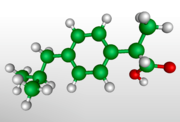|
Find information on thousands of medical conditions and prescription drugs.
|
|
|
Ibuprofen
Ibuprofen is a nonsteroidal anti-inflammatory drug (NSAID) widely marketed under various trademarks including Act-3, Advil, Brufen, Motrin, Nuprin, and Nurofen; a standing joke about some athletes' regular use has produced "Vitamin I" as a slang term for it. It is used for relief of symptoms of arthritis, primary dysmenorrhoea, and fever; and as an analgesic, especially where there is an inflammatory component. Ibuprofen was developed by the research arm of Boots Group. more...
 Home Home
 Diseases Diseases
 Medicines Medicines
 A A
 B B
 C C
 D D
 E E
 F F
 G G
 H H
 I I
 Ibuprofen Ibuprofen
 Idarubicin Idarubicin
 Idebenone Idebenone
 IFEX IFEX
 Iloprost Iloprost
 Imatinib mesylate Imatinib mesylate
 Imdur Imdur
 Imipenem Imipenem
 Imipramine Imipramine
 Imiquimod Imiquimod
 Imitrex Imitrex
 Imodium Imodium
 Indahexal Indahexal
 Indapamide Indapamide
 Inderal Inderal
 Indocin Indocin
 Indometacin Indometacin
 Infliximab Infliximab
 INH INH
 Inosine Inosine
 Intal Intal
 Interferon gamma Interferon gamma
 Intralipid Intralipid
 Invanz Invanz
 Invirase Invirase
 Iontocaine Iontocaine
 Iotrolan Iotrolan
 Ipratropium bromide Ipratropium bromide
 Iproniazid Iproniazid
 Irbesartan Irbesartan
 Iressa Iressa
 Irinotecan Irinotecan
 Isocarboxazid Isocarboxazid
 Isoflurane Isoflurane
 Isohexal Isohexal
 Isoleucine Isoleucine
 Isomonit Isomonit
 Isoniazid Isoniazid
 Isoprenaline Isoprenaline
 Isordil Isordil
 Isosorbide Isosorbide
 Isosorbide dinitrate Isosorbide dinitrate
 Isosorbide mononitrate Isosorbide mononitrate
 Isotretinoin Isotretinoin
 Itraconazole Itraconazole
 Ivermectin Ivermectin
 J J
 K K
 L L
 M M
 N N
 O O
 P P
 Q Q
 R R
 S S
 T T
 U U
 V V
 W W
 X X
 Y Y
 Z Z
Clinical use
Low doses of ibuprofen (200 mg, and sometimes 400 mg) are available over the counter (OTC) in most countries. Ibuprofen has a dose-dependent duration of action of approximately 4–8 hours, which is longer than suggested by its short half-life. The recommended dose varies with body mass and indication. Generally, the oral dose is 200–400 mg (5–10 mg/kg in children) every 4–6 hours, up to a usual maximum daily dose of 800–1200 mg. Under medical direction, a maximum daily dose of 3200 mg may sometimes be used.
Indications
Approved clinical indications for ibuprofen include:
- Rheumatoid arthritis (DMARDs should also be considered)
- Osteoarthritis, ibuprofen can reduce pain and, if present, joint inflammation
- Juvenile rheumatoid arthritis, alone or with corticosteroids
- Morbus Bechterew (spondylitis ankylosans) together with corticosteroids
- Rheumatic fever, together with antibiotic therapy
- Acute gout attack, ibuprofen is not useful for chronic treatment
- Primary dysmenorrhoea (ibuprofen proved superior to placebo and propoxyphen, and at least as effective as aspirin)
- Fever
- Pericarditis, chiefly after myocardial infarction, to reduce pain, fever and inflammation
- Minor aches and pains such as toothache, backache, fever and pain associated with common flu, symptomatic relief of influenza, shingles, and postoperative pain
- Sporting injuries and pain after mild to moderate trauma
- Headache including mild to moderate migraine attack
Off-Label and investigational use
- As with other NSAIDs, ibuprofen may be useful in the treatment of severe orthostatic hypotension (PMID 7041104)
- In some studies, ibuprofen showed superior results compared to placebo in the prophylaxis of Alzheimer's disease, when given in low doses over a long time (PMID 16195368). Further studies are needed to confirm the results, before ibuprofen can be recommended for this indication.
- Ibuprofen has been associated with a lower risk of Parkinson's disease, and may delay or prevent Parkinson's disease. Aspirin, other NSAIDs, and acetaminophen had no effect on the risk for Parkinson's (PMID 16240369). Further research is warranted before recommending ibuprofen for this use.
Ibuprofen lysine
In Europe and Australia, ibuprofen lysine (ibuprofenlysinat, the lysine salt of ibuprofen) is licensed for treatment of the same conditions as ibuprofen. Ibuprofen lysine is said to have a more rapid onset of action compared to base ibuprofen.
Mechanism of action
Ibuprofen is an NSAID which is believed to work through inhibition of cyclooxygenase (COX); thus inhibiting prostaglandin synthesis. As with other NSAIDs, ibuprofen inhibits platelet aggregation, but is not used therapeutically for this action since it is a minor and reversible effect.
Read more at Wikipedia.org
• [List your site here Free!]
|
|
|
|
Pseudodementia associated with use of ibuprofen - Brief Article
From Alternative Medicine Review,
2/1/03
by AL Bernstein
Bernstein AL, Werlin A. Ann Pharmacother 2003;37:80-82.
OBJECTIVE: To report a case of dementing syndrome resulting from ibuprofen use. CASE SUMMARY: A 76-year-old white man with normal mental status became confused, was lost in familiar places, and showed short-term memory loss after beginning a therapeutic regimen of ibuprofen 600 mg 3 times daily for osteoarthritis in anticipation of embarking on a foreign trip. Symptoms of dementia began within 1 week after taking ibuprofen and resolved completely within 1 week after the ibuprofen regimen was stopped. This pattern was repeated 6 months later, when the patient again traveled abroad. Consistently before, during, and alter these events, the patient took atenolol, clonidine, lisinopril, aspirin, vitamin C, lecithin, vitamin E, and multivitamins. DISCUSSION: Using the Naranjo probability scale, we reasoned that the patient's dementia-like syndrome could be attributed to the use of ibuprofen because pseudodementia appeared after the suspected drug was administered, improved when the drug was discontinued, reappeared when the drug was readministered, had no apparent alternative cause, manifested similarly after each exposure to ibuprofen, and was confirmed by the family's observation after both episodes. Objective causality assessment revealed that the adverse drug reaction was probable. CONCLUSIONS: Use of ibuprofen must be considered during clinical evaluation of any patient with new onset of dementing illness. The Naranjo probability scale may be clinically useful for evaluating other pharmaceutical agents that may be contributing to development of dementia-like conditions.
COPYRIGHT 2003 Thorne Research Inc.
COPYRIGHT 2003 Gale Group
Return to Ibuprofen
|
|



